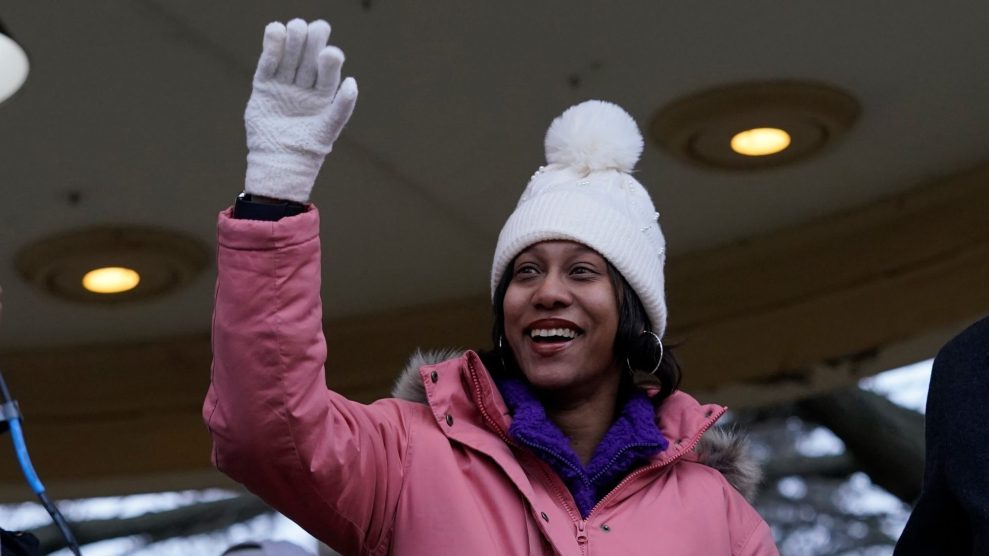
Brittany Watts celebrated with supporters earlier this month after a grand jury declined to indict her on a felony charge for how she handled an at-home miscarriage. Sue Ogrocki/AP
Last week, Brittany Watts, a 34-year-old Black medical receptionist from Ohio, made national headlines when she gave her first television interview after being charged with a felony for how she handled miscarrying a pregnancy at home at the end of last year. The case sparked an outcry from reproductive justice advocates, who have long been concerned with the criminalization of pregnancy.
On Friday, another important detail came out about the case: Watts revealed that it was a hospital nurse who first reported her to law enforcement.
The new detail from Watts is a jarring example of what my colleague Katie Herchenroeder and I reported back in November: that research has shown health care providers were the group of people most likely to report pregnant people for having self-managed abortions under Roe. (Self-managed abortions, or SMAs, occur when someone ends a pregnancy without clinical supervision or support—most often through abortion pills; unintentional miscarriages can sometimes be mistaken as intentional SMAs.)
Experts we spoke with said that this trend was likely to increase post-Dobbs. And they noted that racism and biases can play a role in who health care workers report to authorities. As we wrote:
More than 40 percent of cases featured in the If/When/How report [on people criminalized for ending a pregnancy without supervision from a doctor] “involved minoritized racial and ethnic groups, making people of color disproportionately represented in the sample”…a September report published by the legal advocacy organization Pregnancy Justice showed that poor Black women were overrepresented among those criminalized, along with poor white women, a trend the report attributes to the opioid epidemic’s impact on the latter demographic.
Watts had a miscarriage last September, when she was right around 22 weeks pregnant—the point at which Ohio then banned abortion, “CBS Mornings” reported. (Ohio voters have since approved a ballot measure establishing a constitutional right to abortion until the point of viability, which is usually determined to be around 24 weeks, as my colleague Madison Pauly reported in November.) The miscarriage occurred a few days after Watts’ water broke; prior to the miscarriage, Watts had seen her OB-GYN, who told her the pregnancy would not be viable, and spent two days at a hospital.
Watts told “CBS Mornings” she ultimately left the hospital to go home at the end of each of those two days, against medical advice, because she felt “frustrated” and “ignored” by doctors, who weren’t inducing labor despite knowing her pregnancy was not viable.
“I’m scared, I’m like, ‘there’s a nonviable pregnancy in me, am I going to die?'” Watts said she recalled thinking.
Brittany Watts was 21 weeks pregnant when doctors told her that her pregnancy was not viable and she eventually miscarried at home.
In her first TV interview, Watts tells @Jerickaduncan about then being charged with a felony crime after she suffered a miscarriage. pic.twitter.com/8lfRQuBN9n
— CBS Mornings (@CBSMornings) January 26, 2024
Watts’ medical records, obtained by CBS, show that hospital staff expressed “concerns about Brittany’s verbalization to staff that she wishes to terminate the pregnancy and continues to mention she feels that she is getting or consenting to an abortion.” The records also show that the ethics committee said they’d support induction “if it [is] the professional judgment of the physicians that Brittany is at high risk of bleeding and or serious infection that could lead to death,” and that “if induction occurs, there should be a well documented conversation with her (informed consent) that the procedure is only to prevent harm to her, and is not intended to terminate a potentially viable pregnancy.” Watts told CBS nobody at the hospital ever told her the ethics committee was involved in decisions about her care.
At home, Watts miscarried in her toilet; after, she told CBS, she plunged the toilet and scooped up the contents into a bucket, which she dumped outside, adding that she never saw the actual fetus. (An autopsy report found the fetus died in utero, before delivery, due to complications of premature rupturing of the membranes, the New York Times reported.)
After the miscarriage, Watts went back to the hospital for care, and that’s when she crossed paths with the nurse who ultimately reported her to police.
“The nurse comes in and she’s rubbing my back and talking to me and saying ‘everything’s going to be okay.’ Little do I know, the nurse that was comforting me, and saying that everything was going to be okay, was the one who called the police,” Watts said in the CBS interview.
The 911 audio, obtained by CBS, shows that the nurse said she was calling about a mother who “had a delivery at home and came in without the baby”; when the dispatcher asked if the baby was alive or not, the nurse said Watts “said she didn’t want to look” and that “she didn’t want the baby.” (Watts disputed that allegation, telling CBS she “never said I didn’t want my baby.”) Her medical records, obtained by CBS, show that the nurse contacted police “to investigate the possibility of the infant being in a bucket at the patient’s residence” after the risk management team advised the nurse to do so. Police arrested Watts in October and charged her with felony abuse of a corpse, which carried up to a $2,500 fine and the possibility of a year in prison.
Earlier this month, a grand jury declined to indict her. Watts said she’s speaking out now because “I don’t want any other woman to go through what I had to go through,” adding that she believes she was charged “because of my skin color, honestly, and because there are no laws behind what you are to do in this situation.”
Even though Watts wasn’t ultimately convicted, cases like hers can still have a chilling effect. As If/When/How said in a post on X today about Watts’ latest revelation: “When care providers police their patients, they only make people afraid to get the care they need.”
















